House Extension Solar System

Our home is located in Suffolk (East Anglia, UK), one of the sunniest and driest parts of the UK. Our house faces 154° South (i.e. 26° to the East of South) and the main roof is inclined at 40°. This means it is pretty much ideally orientated for solar PV energy collection according to this orientation calculator. We undertook our first smart home solar installation project in October 2022 and have been really please with the benefits, savings and improvements in our quality of life.
In 2024 we started planning our smart home extension project and it made a lot of sense to consider adding solar panels to the new roof area that will project out from the rear of our home.
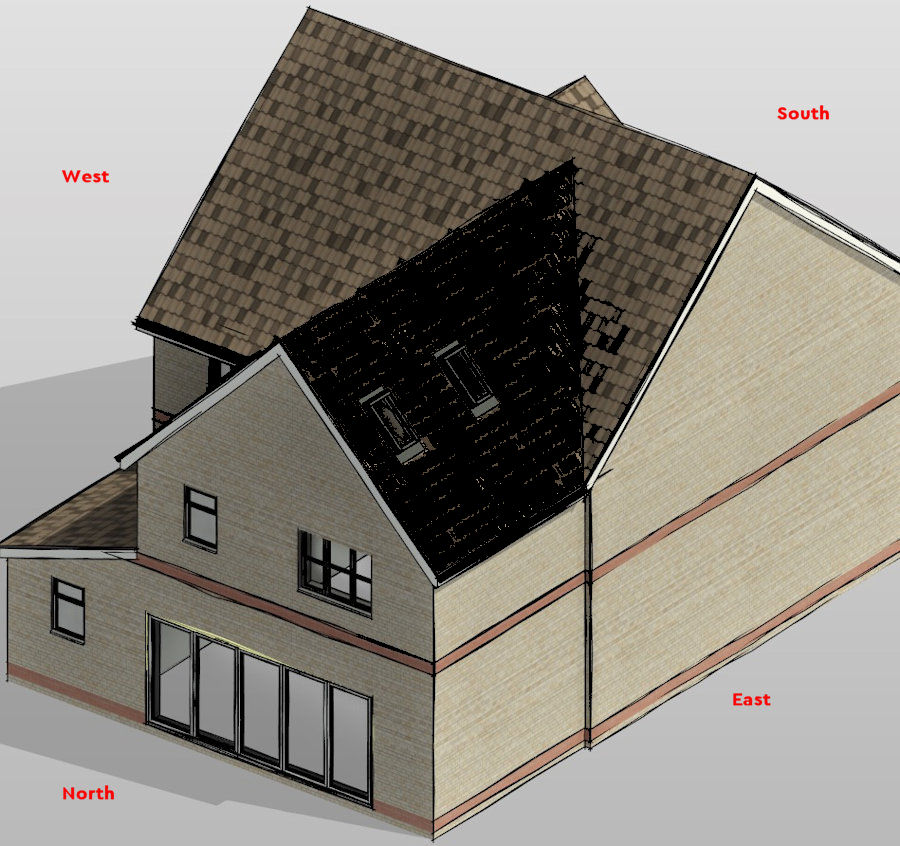
We decided to install "in roof solar panels" on the new extension roof. This gives a cleaner, more integrated look and sits neatly with the planned Velux windows too.
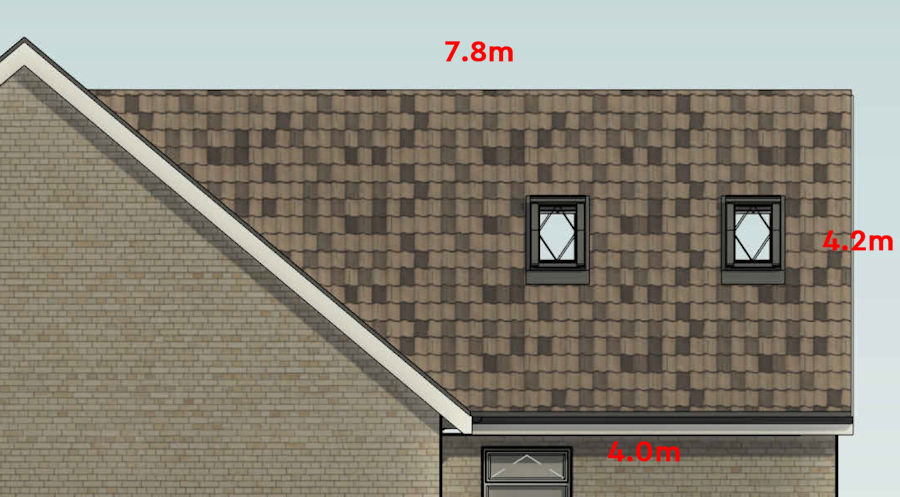
The East facing roof is big enough for a Velux window and six 405W (2430W) solar panels. It will mean we start generating earlier in the day and generate more during day.
The West facing roof is the same size and it will mean we generate much later into the evening and thus much more during any peak rate period.
These solar panels will be partially shaded by the existing roof so we plan to use Enphase microinverters again.
Installing a solar roof from the outset means we avoid the additional costs of the standard roof, scaffolding, bird protection mesh, etc. The additional cost is quite small and these panels will never experience perpendicular sunlight, so they will not get excessively hot.
In Roof Solar Panels
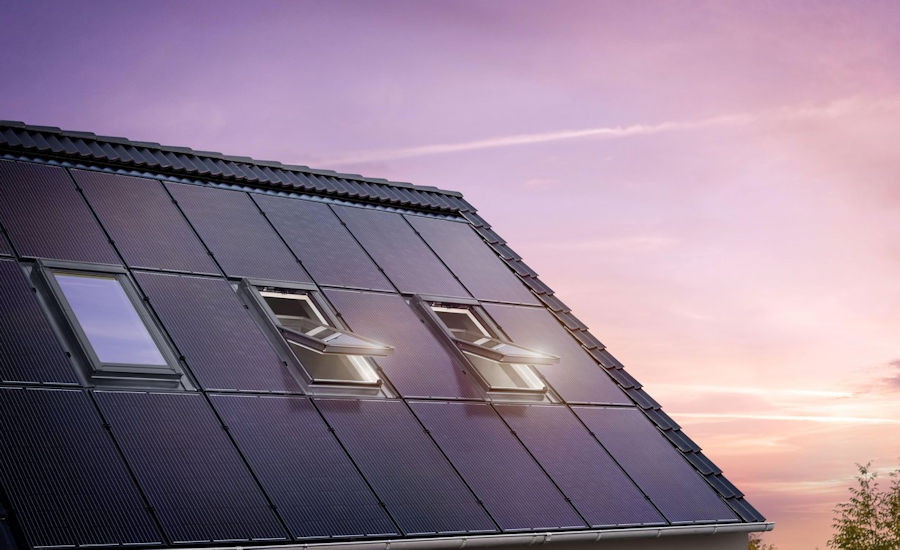
The main reasons for choosing an 'in roof' solution are the aesthetics and the ability to integrate seamlessly with the Velux windows. It also avoids fitting a new roof and then covering it up with solar panels.
We know that in roof solar panels can be less efficient as they get hotter but, they will not be South facing so this will be less of an issue. In roof solar panels are also more expensive to fit. With an in roof solar system, we do not require any bird protection mesh.
In-roof solar panels still require a 400mm border around them. One challenge with in roof solar installations can be finding panels that fit in landscape orientation.
GSE
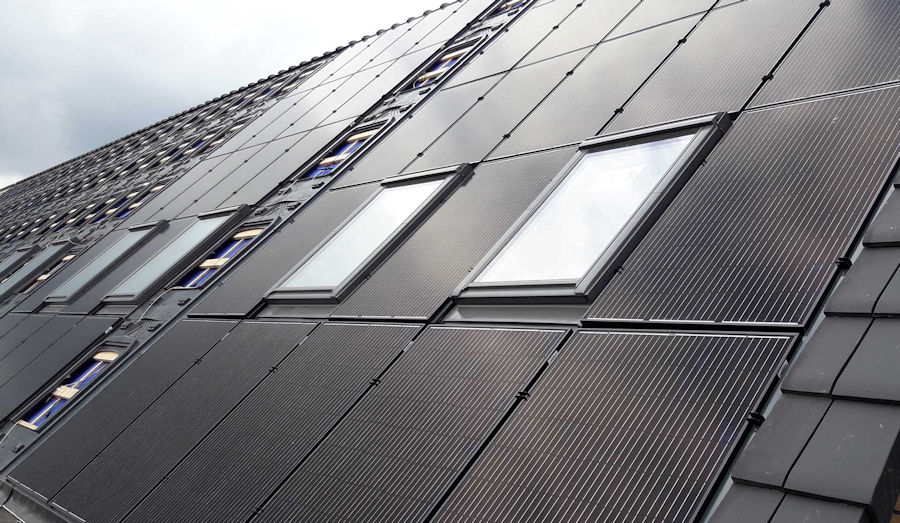
The GSE in-roof mounting system seems a popular choice. They use plastic trays but, they seem to work with many types and size of panels and they have also partnered with Velux. GSE have a list of panels that they certify to work with their mounting system.
With this system the panels are lifted slightly off the trays and trays work as a gully system for rain. This combined with the large raised holes (4 per panel) allows airflow and hence cooling.
Viridian

The Viridian in-roof mounting system seems to be very well regarded in the solar Facebook groups but, more expensive as it uses aluminium mounting trays.
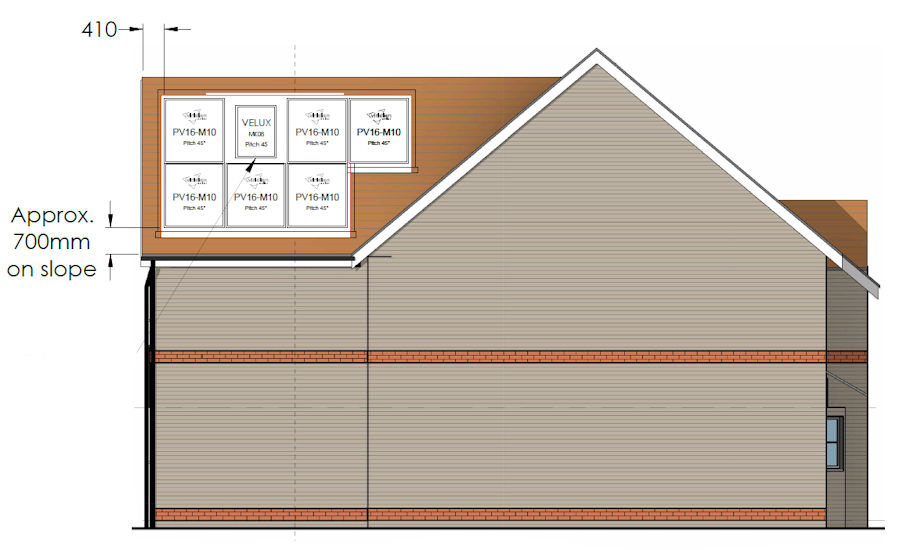
Viridian provided a design based upon six PV-16 405W solar panels and a single MK08 Velux window. Whilst the architects drawings had two windows on each side, this design works better in my view. This provides 2430W of panels on both roof aspects and with Enphase IQ8HC microinverters, each roof could deliver up to 2280W.
Estimated Generation
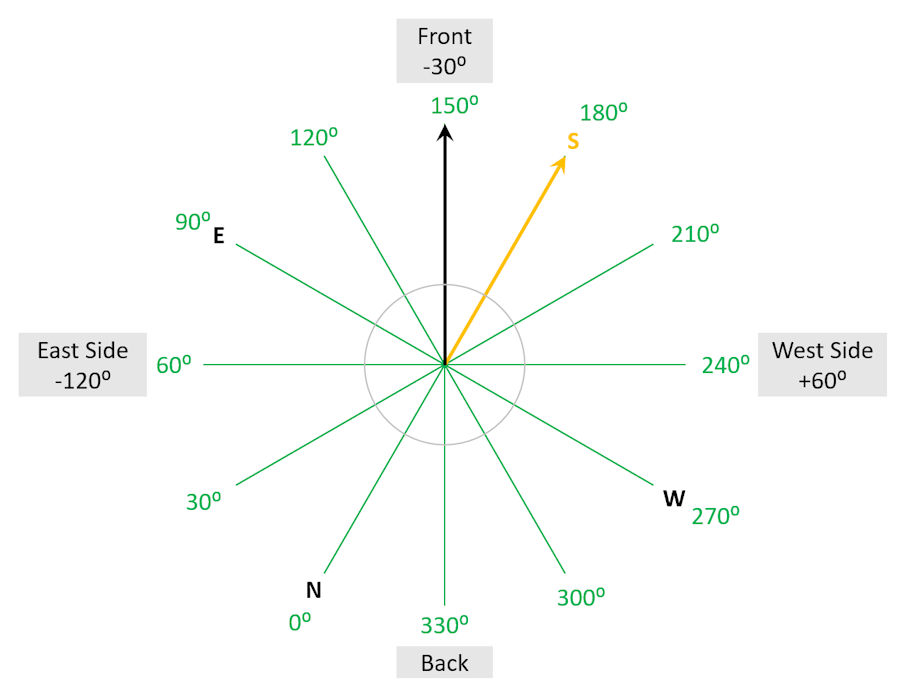
It is possible to predict the monthly energy generation for both aspects using the European Union PVGIS service. The numbers generated by this tool do not factor in the shading that occurs due to our existing roof though. For simplicity we have assumed the front of our house is 30° East of South. In reality it is 26°.
For now, I have assumed the peak output of the solar panels on each new roof aspect is 2400W and that each roof will slope at 45°.
In the middle of summer, the sun is rising from 60° at about 6am above our neighbours house, so it hits the East facing roof. The sun is high enough to hit both the East and West roof through most of the day. It sets to the West and hits the horizon at around 9pm and at 300°
In the middle of winter, the sun does not get high enough to hit the East & West facing roof aspects during the day.
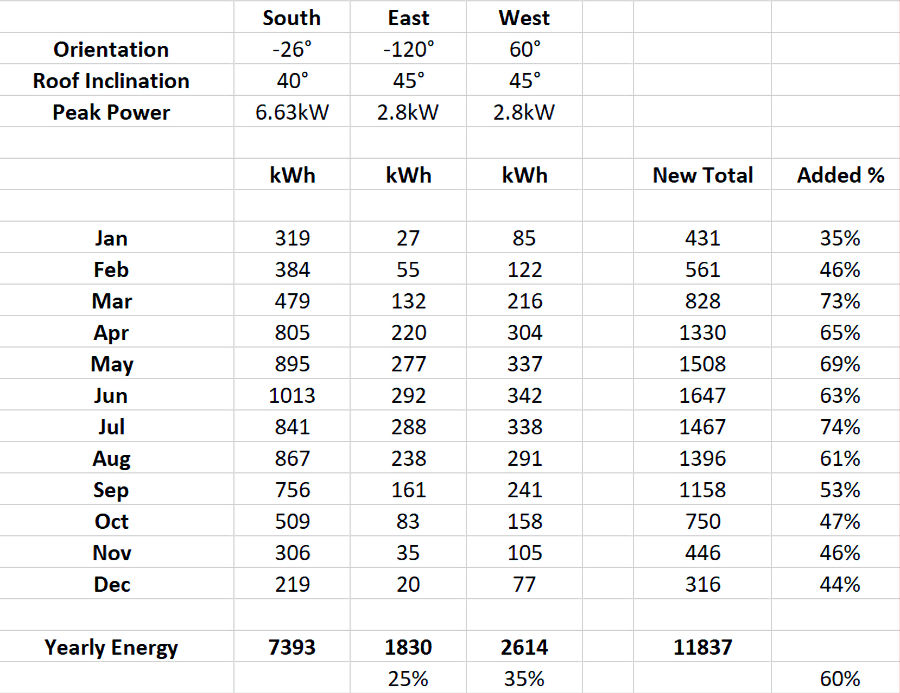
The PVGIS figures show that the new solar panels would add about 3900kWh per year. Our existing 6.63kW South facing roof generated 7400kWh in 2023.
The combined figure is 11,300kWh and about 53% more than we currently produce over a whole year.

The additional solar panels will not just provide more peak power. They will 'fatten out' our daily generation curve (this one is from July 2023), to start generating more power earlier in the day and to then continue generating more power later into the day. This means more energy will generated each day and a lot more energy will be generated in the 'peak rate' evening period. The 'tail' currently captured at the end of each day will be filled out. In theory, we could produce more than 70kWh on a good day.
Export Limits & Approvals
Before this project was started we had a 6.63kW system with 6.0kW of Enphase microinverters and we rarely saw the peak generation exceed 5.8kW, though in (rare) ideal conditions we have observed 6.1kW. Given that our home typically uses 300-500W, we typically export a maximum of 5.4kW. Our additional solar generation would allow us to exceed 6.63kW though, so requested that our installer applied to get our export limit increased. We would still have added these panels, even if we didn't get a higher export limit though.
In early May 2025 we got a letter through from UK Power Networks saying that we now have approval to export up to 11.19kW 😎
Return On Investment
One big factor with the Return On Investment (ROI) of this planned addition to our solar system is that an in-roof system avoids the need to buy a new roof for our extension and then cover it up with solar panels. The ROI of a solar system that is not South facing and is also subject to shade is going to be much longer though. The 'payback period' with this addition to our smart home solar installation project is going to be much longer but, we don't really mind. The benefits it brings and the improved quality of life mean that the investment is easily justified.
Benefits & Quality Of Life
I am adding a solar roof to our extension to improve our quality of life. The additional solar energy generated means:
- We will be able to charge our CUPRA Born and other electric vehicle at a faster rate and in less time using solar energy. We should be able to regularly hit the 7.4kW limit of our Zappi smart EV charger. Our current tariff is a key factor in deciding to use solar power for EV charging but, there are tariffs where it makes good financial sense.
- We will export more solar energy and get paid a good price for it.
- We will be able to run more appliances whenever we want. We very rarely hit the 5kW discharge limit of our Tesla Powerwall but with more solar panels this will not be an issue. Specifically, we will be able to use the cookers and hob using solar well into the evening.
- The extra generation will easily cover the extra power required to run the extension & master bedroom air conditioning.
Tesla Powerwall 2

I looked at adding a second Tesla Powerwall to our system, to ensure some of the planned HVAC components can run on cheap rate electricity throughout the whole day. It would also mean we can run our home through longer power outages and the two Powerwalls will be able to handle house loads up to 10kW. Both will charge at 5kW too and take less than 3 hours to fully charge on cheap rate electricity.
Having worked through the numbers, a second Powerwall 2 simply can't be justified on financial grounds. Doubling our battery storage for to handle the less than 1% of the time that our single Powerwall 2 is not enough just doesn't make financial sense.
Summary
I've got three quotes to do this work and they varied by about £3000. I did not chosen with the cheapest supplier because they didn't respond to my follow up questions. I have also not gone with Greenscape Energy Ltd again, because they were slower to respond and they just didn't give me the same level of confidence. They were also the most expensive quote. This was a real shame, because I was really impressed with them when they installed our smart home solar installation project. So I am using a new (to me), local supplier and will name them once the installation has been completed.
It is fair to say that in-roof solar panels, especially ones with microinverters are a LOT more expensive than the more traditional on-roof solution but, I'm not tasing this approach for financial reasons alone. It is a much more aesthetically pleasing solution for our new extension and it extends our (already impressive) solar generation capability, to future-proof our home a little bit more.


